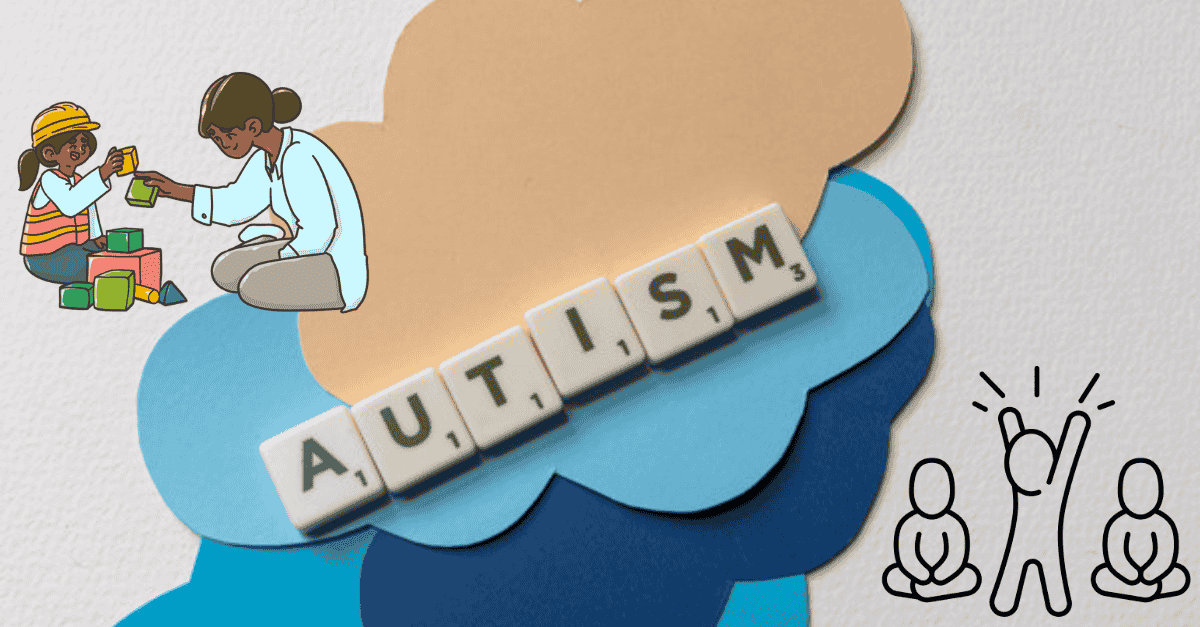Symptoms of Autism Spectrum Disorder (ASD)
Autism Spectrum Disorder (ASD) is a developmental condition that affects a child’s behavior, communication, social interactions, and learning. The symptoms of ASD can differ widely between individuals, varying in severity from mild to severe. Some children may show signs of autism very early in life, while others might not be diagnosed until later childhood.
Early Signs of Autism in Children
Autism can typically be detected by the age of 2 or 3, although some signs may be noticeable even earlier. One of the most common early indicators of ASD is delayed speech and language development. Children with autism might not develop speech as expected, and they may also have trouble understanding social cues or using words for communication. Additionally, a lack of gestures such as pointing, waving, or nodding might be present, which can impact non-verbal communication.
Another early sign of autism is a limited interest in social interactions. Children with autism might avoid social engagement with family members or other children, showing little interest in games such as peek-a-boo or other typical social activities. Some children may also engage in repetitive behaviors, such as hand-flapping, rocking, or repeating words or phrases. These repetitive actions are common and may also be reflected in play, with children focusing intently on one object or activity, such as lining up toys or watching the same video repeatedly.
Children with autism are often more sensitive to sensory stimuli compared to their peers. This sensitivity can include an aversion to loud noises, certain textures, or bright lights, and may cause distress when these sensory inputs become overwhelming.
Common Behavioral Symptoms of ASD
Children with autism may display a variety of behavioral symptoms. One common characteristic is the presence of repetitive behaviors, such as repetitive movements like rocking or hand-flapping, or a need for rigid routines and rituals. These behaviors can help children with autism feel more in control or reduce anxiety, but they can interfere with daily activities.
Many children with ASD also develop intense, focused interests in specific topics or objects. These interests can sometimes become so all-consuming that they exclude other activities or subjects, limiting the child’s interactions with their environment.
Transitions between activities or environments can also be challenging for children with autism. A change in routine, such as moving from one activity to another or going to a new place, may result in distress, tantrums, or resistance. Unpredictability in their surroundings can trigger anxiety or frustration.
Some children with autism experience unusual eating and sleeping habits. For instance, they may develop a very limited diet, preferring only a small range of foods, or they might struggle with sleep disorders such as difficulty falling asleep or waking up frequently during the night.
Motor coordination issues are also common in children with autism. They may have difficulties with fine motor skills like handwriting or using utensils, as well as gross motor skills, such as running or jumping. These challenges can affect their ability to engage in physical activities or tasks that require manual dexterity.
Causes and Risk Factors of Autism Spectrum Disorder
The exact cause of Autism Spectrum Disorder (ASD) remains unclear, but research suggests that a combination of genetic, environmental, and developmental factors contribute to its onset. ASD is believed to result from a complex interplay between biological and environmental influences, affecting brain development and functioning.
Genetic Factors in ASD
Genetic factors are crucial in the development of autism. Research has found that ASD often runs in families, suggesting a hereditary influence. Specific genes involved in brain development and function may be linked to the disorder. It is believed that multiple genes, each contributing a small effect, combine to increase the risk of ASD. However, no single gene has been identified as the sole cause, and many of these genetic factors interact with environmental influences.
In some cases, genetic mutations or variations may increase the likelihood of a child developing autism. For instance, certain rare genetic conditions, such as fragile X syndrome, Rett syndrome, and other chromosomal abnormalities, are associated with a higher incidence of autism. Additionally, recent advances in genomics have led to the discovery of more complex gene-environment interactions that may influence the development of ASD. While genetic research is ongoing, it is clear that genetics plays a major role in ASD susceptibility.
Environmental Influences and Risk Factors
Environmental factors, while not the sole cause of autism, may play a role in its development, especially in combination with genetic predisposition. These factors are varied and can include prenatal, perinatal, and postnatal influences.
Prenatal factors such as maternal age, infections during pregnancy, or exposure to certain medications and toxins may contribute to the risk of autism. For instance, children born to older parents, particularly older fathers, may have a slightly higher risk of developing ASD. Prenatal exposure to substances like alcohol or drugs, including certain antidepressants (SSRIs), has also been linked to an increased risk. Infections like rubella or Zika virus during pregnancy may increase the likelihood of autism, though the evidence is still being studied.
Perinatal factors—those related to birth—may also play a role. Complications during labor and delivery, such as oxygen deprivation or low birth weight, are thought to contribute to an increased risk of autism, though these factors alone are unlikely to cause the disorder. Premature birth, as well as difficulties with the early stages of development, may also affect brain development in ways that increase the likelihood of ASD.
Other postnatal environmental factors, such as lead exposure, maternal stress, or a lack of early childhood stimulation, could further influence the development of autism, but the research in these areas is still evolving. It’s important to note that while these environmental factors can increase the risk, they are rarely the sole cause of ASD.

The Role of Brain Development in ASD
Brain development is at the heart of Autism Spectrum Disorder. Studies show that differences in brain structure and function are commonly observed in individuals with ASD, though the exact nature of these differences is still being explored.
Research has identified that individuals with autism often exhibit abnormalities in areas of the brain involved in communication, social behavior, and sensory processing. One of the most prominent findings is an overgrowth of brain tissue in early childhood, particularly in areas such as the frontal cortex, which is involved in higher cognitive functions like planning, attention, and decision-making. This overgrowth may affect the way the brain processes information, leading to the social and communication difficulties that characterize autism.
The amygdala, a brain structure involved in processing emotions, has also been found to function differently in people with ASD. This could explain some of the emotional and social challenges that individuals with autism experience, such as difficulty understanding and responding to social cues or regulating emotional responses. Similarly, the mirror neuron system, which is involved in understanding others’ actions and emotions, has been found to function atypically in many individuals with autism, possibly contributing to difficulties with empathy and social connection.
Treatment and Therapies for Autism Spectrum Disorder
While there is no cure for Autism Spectrum Disorder, a variety of treatments and therapies can help individuals with autism develop essential skills, manage symptoms, and lead fulfilling lives. The approach to treatment is highly individualized, as each person with autism has unique strengths, challenges, and needs.
Behavioral Therapy and Autism
One of the most widely used and evidence-based treatments for autism is Applied Behavior Analysis (ABA). ABA is a type of behavioral therapy that focuses on encouraging positive behaviors and discouraging undesirable ones through structured interventions. This approach breaks down tasks into smaller, manageable steps and reinforces desired behaviors with rewards. ABA therapy can be used to teach a wide range of skills, including communication, social interactions, and self-care, and is often used in both home and school settings.
Another approach is Early Intensive Behavioral Intervention (EIBI), which is a more intensive, early intervention form of ABA, typically used with children under the age of 5. This therapy aims to improve cognitive, language, and social skills through repeated practice and reinforcement.
Speech and Language Therapy for ASD
Speech and language therapy is essential for many children with autism, as difficulties with communication are one of the core features of the disorder. Speech therapists work with children to improve verbal and non-verbal communication skills, helping them learn how to express themselves more clearly and understand language better. Therapy may focus on improving articulation, language comprehension, social communication, and using alternative communication methods, such as sign language or communication devices, if needed.
Children with autism often struggle with pragmatics (the social use of language), so speech therapy can also address how to initiate and maintain conversations, understand humor, and respond to social cues. Early speech therapy can significantly improve a child’s ability to communicate effectively and interact socially.
Medication and Medical Interventions
There is no medication that can cure autism, but some medications may be used to manage certain symptoms or co-occurring conditions, such as anxiety, depression, or hyperactivity. Medications like selective serotonin reuptake inhibitors (SSRIs), stimulants, or antipsychotics may be prescribed to address specific behavioral or emotional challenges that interfere with daily functioning.
For example, children with autism who experience severe anxiety or repetitive behaviors may benefit from medications to reduce these symptoms and improve their ability to participate in therapies or social interactions. It is important to note that medication is often used in conjunction with other therapies and not as a standalone treatment for autism.
Alternative Therapies for Autism Spectrum Disorder
In addition to traditional therapies, some families explore alternative therapies for managing autism. These therapies often aim to address sensory, cognitive, or behavioral challenges in ways that differ from conventional treatments. However, it’s important to approach alternative therapies with caution, as there is limited scientific evidence to support their effectiveness.
Some popular alternative therapies include:
- Sensory Integration Therapy: Aims to help children with autism who have sensory processing difficulties. The therapy involves controlled exposure to sensory stimuli (e.g., sounds, textures) to help children learn to respond to these stimuli in a more regulated way.
- Dietary Interventions: Some parents opt for specialized diets or nutritional supplements in hopes of reducing autism symptoms. For example, gluten-free or casein-free diets are sometimes explored, though research on their effectiveness is inconclusive.
- Animal-Assisted Therapy: This therapy involves interactions with animals, such as therapy dogs, and can be particularly helpful in improving social skills and emotional regulation.
- Music Therapy: Uses music and rhythm to enhance communication, social skills, and motor skills, and has been shown to have positive effects for some children with autism.
Conclusion
Autism Spectrum Disorder (ASD) is a complex neurodevelopmental condition that affects a child’s behavior, communication, and social interactions. While the exact causes of autism remain unclear, research indicates that a combination of genetic, environmental, and developmental factors contribute to its onset. Early diagnosis, through screening and comprehensive evaluation, is crucial for identifying ASD and ensuring that children receive the support they need as soon as possible. The earlier a child is diagnosed, the better the outcomes in terms of communication, social skills, and overall development.
Treatment for autism is highly individualized, and there are various therapeutic options available, including behavioral therapies, speech and language therapy, and medical interventions. Early intervention programs have been shown to significantly improve skills and minimize the impact of autism on daily life. While there is no cure for ASD, many children can lead successful and fulfilling lives with the right combination of therapies and support.



